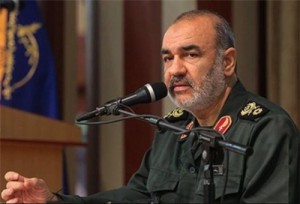 TEHRAN (FNA)- Lieutenant Commander of the Islamic Revolution Guards Corps (IRGC) Brigadier General Hossein Salami�said Iran is among the only three world country enjoying an indigenous ballistic missile technology.
TEHRAN (FNA)- Lieutenant Commander of the Islamic Revolution Guards Corps (IRGC) Brigadier General Hossein Salami�said Iran is among the only three world country enjoying an indigenous ballistic missile technology.�Many countries may have access to cruise missiles technology, but when it comes to ballistic missiles, I am confident that only the US and the (former) Soviet Union could master this technology, and now we can announce that we own this technology as well,� General Salami told FNA on Tuesday.
He pointed to Iran�s capabilities in the field of Unmanned Aerial Vehicles (UAVs), and said, �While we did not have any knowledge about drones, we have developed and acquire drones that travel 2,000 kilometers, conduct their operations and then land in our desirable regions.�
Earlier this month, General Salami said the precision targeting of IRGC's ballistic missiles has been improved to have a margin of error near zero.
�Our situation has improved now because our ballistic missiles margin of error (in precision targeting) is near zero now,� General Salami said in a ceremony held in Tehran to commemorate the martyrs who were killed in a blast at the IRGC base on November 12, 2011, including General Hassan Tehrani Moqaddam who was in charge of the IRGC's Arms and Military Equipment Self-Sufficiency Program.
He pointed to the role played by the late commander and head of the IRGC Missile Research Center, Martyr Major General Tehrani Moqaddam, in the designing and production of high-precision ballistic missiles, and said, �Due to such attempts the precision of Iran�s ballistic missiles has approached (a) zero (margin of error) and our ballistic missiles target moving vessels on the sea and they operate against (enemies') command and control centers.�
�Martyr Tehrani Moqaddam led us to self-sufficiency in area of ground-to-ground missiles and his ideas resulted in the development of an innovative missile power for Iran,� he added.
Earlier this year, Commander of the IRGC Aerospace Force General Amir Ali Hajizadeh said that Iranian experts at the IRGC Aerospace research center have increased the precision capability of the 'Persian Gulf' supersonic ballistic missile to a maximum margin of error of 8.5 meters.
Hajizadeh said the late commander and head of the IRGC missile research center, Martyr Major General Tehrani Moqaddam, played a major role in the designing and production of the Persian Gulf Missile.
"When in its second test the Persian Gulf missile hit a moving vessel with 30m precision, we felt to have made a great success," Hajizadeh said in June.
"When we explained the achievement to the Supreme Leader, His Excellency voiced pleasure in the increased precision of the missile, but demanded us to increase its precision capability to less than 10-15 meters," he added.
"Less than 6 months later, our experts improved the precision capability of this missile to less than 8.5m," General Hajizadeh continued.
"And when the Persian Gulf missile came into operation in the IRGC Navy, the countdown started for the trans-regional countries to end the mission of their warships," the IRGC Aerospace commander stressed.
The supersonic projectile, which carries a 650-kilogram payload, is smart and immune to interception, and features high-precision systems.
The Persian Gulf supersonic ballistic missile is the most advanced and most important missile of the IRGC Navy.
The distinctive feature of the missile lies in its supersonic speed and trajectory. While other missiles mostly traverse at subsonic speeds and in cruise style, the Persian Gulf moves vertically after launch, traverses at supersonic speeds, finds the target through a smart program, locks on the target and hit it.
The range of the solid-fuel missile is 300km and it can be fired from triple launchers.
The missile could successfully hit a mobile target one-tenth of an aircraft carrier in its early tests.
In early 2011, Iran started the mass-production of the Persian Gulf anti-ship missile which is designed to destroy targets and hostile forces at sea.
In April 2012, Hajizadeh noted the production of the Persian Gulf ballistic missiles, and said, "The research and testing phase of the Persian Gulf missile ended last year, and it is now being mass produced by the Defense Ministry."
Also in the same month, IRGC Navy Commander Rear Admiral Ali Fadavi underlined Iran's high defensive capabilities and power, and said the newly developed 'Khalij-e Fars (Persian Gulf)' missile would make the enemies change their equations and calculations due to its unusual and unique features.
"The Persian Gulf missile has been developed somehow different from the usual trend and can change the equations on which the enemy most relies," Fadavi said at the time.
Referring to Iran's missile power, he said that Iran is now in possession of home-made missiles with the range of over 200km which can be mounted on Iranian high-speed boats.
In July 2012, Iran's Persian Gulf missiles displayed their 100 percent precision capability after hitting and destroying the specified targets in the last phase of the Payambar-e Azam 7 (The Great Prophet 7) drills.
"The Persian Gulf missile precisely hit and destroyed the target which was several times smaller than the marine targets which can pose a threat," Commander of the IRGC Aerospace Force said at the end of the last phase of the wargames on July 4, 2012.
By Fars News Agency
The Iran Project is not responsible for the content of quoted articles.










